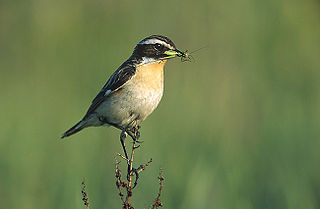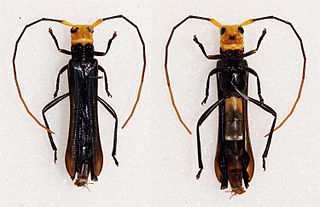
Malpighia emarginata is a tropical fruit-bearing shrub or small tree in the family Malpighiaceae.

Chats are a group of small Old World insectivorous birds formerly classified as members of the thrush family (Turdidae), but following genetic DNA analysis, are now considered to belong to the Old World flycatcher family (Muscicapidae).

Libinia emarginata, the portly spider crab, common spider crab or nine-spined spider crab, is a species of stenohaline crab that lives on the Atlantic coast of North America.

Prunus emarginata, the bitter cherry or Oregon cherry, is a species of Prunus native to western North America, from British Columbia south to Baja California, and east as far as western Wyoming and New Mexico. It is often found in recently disturbed areas or open woods on nutrient-rich soil.

Idaea emarginata, the small scallop, is a moth of the family Geometridae. It was first described by Carl Linnaeus in his 1758 10th edition of Systema Naturae and it is found in Europe.

Oraesia emarginata is a species of moth of the family Erebidae first described by Johan Christian Fabricius in 1794. It is found in Australia, New Caledonia, Indonesia, New Guinea, Pakistan, the Philippines, India, Sri Lanka, Sulawesi, Taiwan, China, Japan, Korea and Nepal as well as Eritrea, Ethiopia, Kenya, Namibia, Nigeria, South Africa, Tanzania, the Gambia, Uganda, Oman and Yemen.

Saperdini is a tribe of longhorn beetles of the subfamily Lamiinae.

Neonitocris is a genus of longhorn beetles of the subfamily Lamiinae, containing the following species:
Neonitocris atra is a species of beetle in the family Cerambycidae. It was described by Karl Jordan in 1894.

Neonitocris princeps is a species of beetle in the family Cerambycidae. It was described by Karl Jordan in 1894, originally under the genus Nitocris. It has a wide distribution in Africa.
Neonitocris regina is a species of beetle in the family Cerambycidae. It was described by Karl Jordan in 1894.
Neonitocris flavipes is a species of beetle in the family Cerambycidae. It was described by Stephan von Breuning in 1950.
Neonitocris gaboniensis is a species of beetle in the family Cerambycidae. It was described by Stephan von Breuning in 1956.
Neonitocris infrarufa is a species of beetle in the family Cerambycidae. It was described by Stephan von Breuning in 1956.
Neonitocris sibutensis is a species of beetle in the family Cerambycidae. It was described by Stephan von Breuning in 1956.
Neonitocris spiniscapus is a species of beetle in the family Cerambycidae. It was described by Stephan von Breuning in 1956.
Neonitocris calva is a species of beetle in the family Cerambycidae. It was described by James Thomson in 1868.
Neonitocris mangenoti is a species of beetle in the family Cerambycidae. It was described by Lepesme and Stephan von Breuning in 1953.
Neonitocris plicata is a species of beetle in the family Cerambycidae. It was described by Hintz in 1919.
Neonitocris rubriventris is a species of beetle in the family Cerambycidae. It was described by Hintz in 1919.







